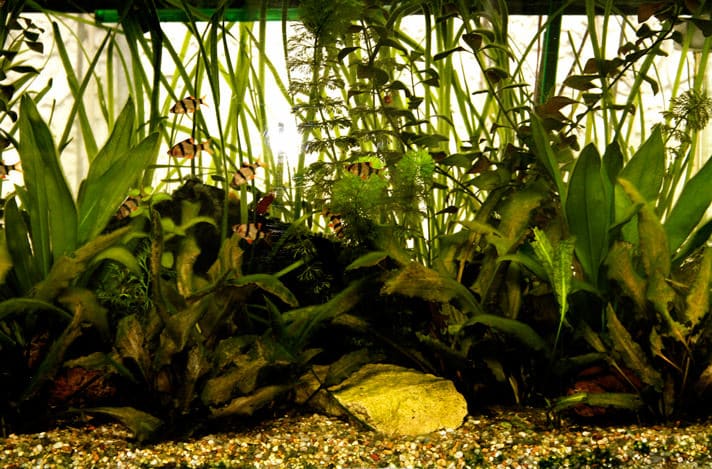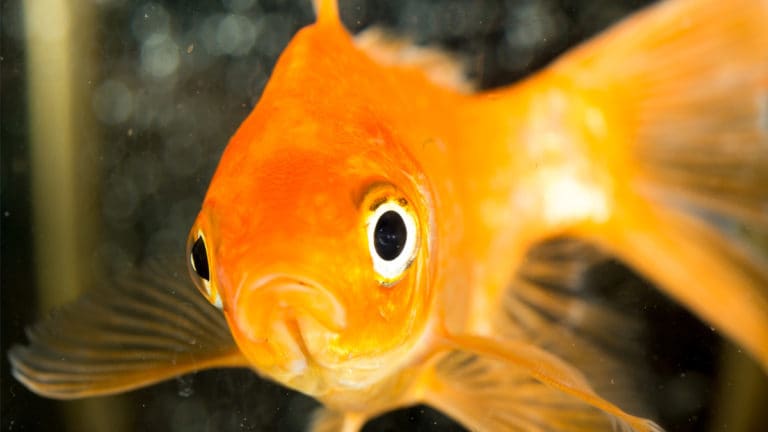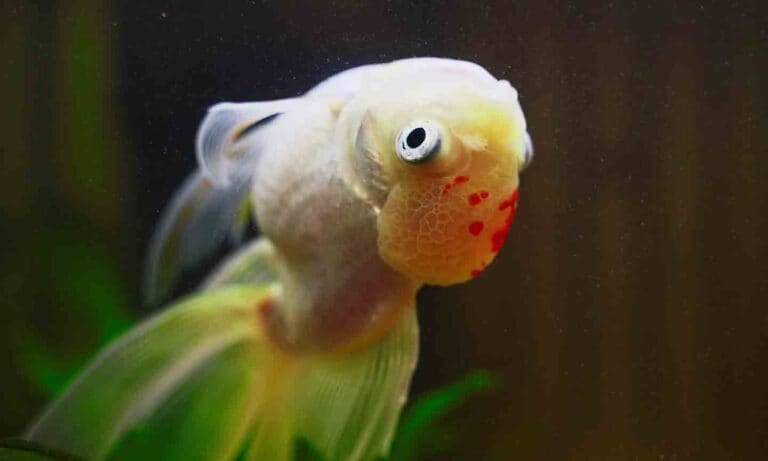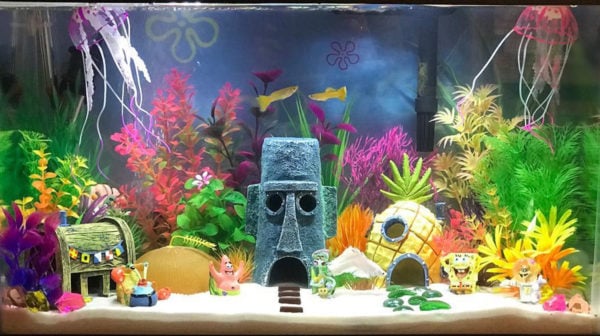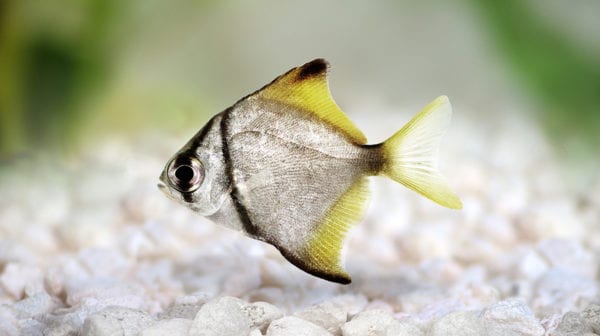Because we think of plants as important aquascaping elements, we don’t want our fish eating them—but perhaps we need to rethink the concept. This article is about live aquatic plants for your aquarium that will serve as food for your fish. These plants will grow fast enough and be palatable to your fish so that they can nibble on them for a source of nourishment.
Criteria for the Plants
First off, the aquatic plants we are looking for have to be attractive. They have to look good in the aquarium even when the fish have been nibbling on them. They also have to grow fast enough to keep up with, or ahead of, the efforts of your fish to nibble them down. The goal is to try and achieve a balance between the plants growing and the fish munching on them.
Not just any plants will do. They need to be sturdy enough that they won’t fall apart because of the attention of the fish, and yet be edible and soft enough to provide food for the fish. The plants should be fast-growing yet not so fast that they take over the aquarium if the fish can’t keep up with this growth.
Conditions for Growing the Plants
Without going into a detailed dissertation on how to grow live aquatic plants, I’m going to suggest a few simple ideas. “Simple” is the operative word here. Even though I am a loyal member of the Aquatic Gardeners Association, I realize that most hobbyists may not want to mess around with expensive lighting, carbon dioxide injection and all kinds of additives. That’s fine, because with very simple equipment, you can grow plenty of lovely plants that your fish will enjoy eating.
To start with, the plants need a good substrate. Plain old aquarium gravel is not sufficient for plants. They really need the special substrates now available for aquatic plants. These provide most of the nutrients plants require.
In addition to the right substrate, the plants need to receive enough light and the right kind of light. A single fluorescent tube in an aquarium reflector is not enough to grow aquatic plants. You need to have either two tubes or more intense light, such as that provided by compact fluorescents or T5 fluorescents.
Find the best local fish store for plants — the one with plants kept properly in well-lit aquariums, in the right substrate, with filters in the aquariums. Ask what light they recommend for growing plants. Also, it’s a good idea to buy your plants from them, because you will get ones that have been acclimated to local water conditions.
Good Food Plants
In discussing the specific plants that will make good food for your fish, I’m going to mention only the ones that you will probably find at your local fish store. Also, unlike fish, in which there are a number of common names for each fish, aquatic plants are pretty much referred to by their scientific name. Using their Latin names helps you find the right aquatic plants and know what you’re working with.
I’ve broken down the plants into basic categories. This will help you choose the kinds you want and understand how they’re used in aquariums.
Algae-covered rocks
The simplest aquatic plants are algae, and the simplest food plant setup for your fish is algae-covered rocks. All you have to do is to put some rocks in water in a container separate from the main fish aquarium, and set them where they get sun all day long. When they become covered with algae, which usually takes a week or two, put them in the aquarium, and put some new rocks in the water in the sun. As the fish in the aquarium consume the algae on the rocks, rotate in new ones. All fish really appreciate this unending source of food plants, especially the algae-grazing cichlid fish from the African lakes.
Algae or “moss” balls
This is a really fascinating form of algae that looks like a golf ball covered in green moss. It comes from large lakes in Europe and Japan, where it rolls around at the shore of the lake. They make excellent fish food, and I’ve had success using them with many different fish. They always grow in a round shape. The fish are always nibbling on them, and yet they never eat them completely. These can be expensive but are well worth the price.
Plants tied to rocks or driftwood
One of the best ways to provide growing plants for fish to eat is to attach either Riccia or Java moss (Vesicularia) to driftwood or rocks using cotton thread. As the aquatic plants grow, they naturally adhere to the rock or driftwood and provide excellent food plants for fish. Some stores sell these rocks and driftwood already combined.
Soft bunch plants
I’m going to mention many different species, but you really need to be very careful about which plants are legal in your state. Some states do not allow any aquatic plant that is not native to be sold or imported. Others have different laws about what you can possess and what you can import. Please check with your local state agency.
-
Cabomba. This comes in many different forms, and in both red and green. It’s a very beautiful plant, and if given enough light, it grows quite fast. The leaves form whorls from the stem. The aquatic plant is very soft and edible by many fish.
-
Egeria (Anacharis, Elodea). This is probably the most common plant around. This is the one you were told when you were a kid to put in a fish bowl to provide oxygen. Like Cabomba, this aquatic plant is a fast-grower and soft enough to be eaten by all fish.
-
Limnophila, also known as Ambulia. This plant is very fine-leaved and delicate, but it grows rapidly in good light. Depending on the number and type of fish, Limnophila may not be able to maintain sufficient growth to stay ahead of the fish eating it.
-
Myriophyllum. Another soft-leaved aquatic plant, Myriophyllum grows so fast that it can almost always stay ahead of the fish eating it. It comes in many different forms and species.
-
Rotala also comes in many different species, the most common ones being indica, wallichii and rotundifolia. Any Rotala are perfect plants for our purposes, because they have soft enough leaves that fish will nibble on them, but they are tough enough not to be completely eaten. If you have very strong light in the aquarium, there’s a beautiful red species called R. macrandra that is exceptional.
Ground covers
There are two plants I would like to mention that are very good for ground cover, in that they will spread along the bottom of the aquarium if there is sufficient light. They also both have very small leaves and can provide food for a number of fish. The aquatic plants are Glossostigma and Lilaeopsis. These two aquatic plants are usually best purchased in small pots, and you need to provide them with plenty of light.
Hygrophila
Plants in the Hygrophila genus needs to be mentioned simply because it is so common, and there are so many species of it available. Better known as hygro, this is one of the fastest-growing aquatic plants there is, and it is excellent as a starter plant. It is a stem plant; as it grows, the bottom leaves becomes softer, and the fish will graze on them.
Nymphaea
These are the water lilies and water lotus, and are very hardy plants that send leaves up to the surface. If you pinch off these leaves before they reach the surface, the aquatic plant will soon put out leaves that stay on the bottom of the aquarium. As these age, they become very soft and are an excellent source of plant food for fish.
Floating plants
These are also good food plants for fish, but they have the problem of sometimes of taking over the aquarium. Floating plants are especially good for goldfish and koi, which will eat them greedily. The best floating plants are duckweed (e.g., Lemna minor), Azolla and Salvinia.
Aponogeton
This is a group of aquatic plants consisting of a bulb or tuber that puts out a large number of leaves that reach to the water surface. Aponogeton will flower easily in the aquarium if given sufficient light. Fish will eat the leaves as they age and soften (and some fish will eat them all the time), and they will also always eat the flowers and seeds as they fall back into the water. These plants are often available at the local fish store in the bulb form sometimes called “wonder bulbs” — and they really are. All you have to do is push them into the substrate, and within a week, you have a plant.
Unedible Plants
Although the majority of this article has been devoted specifically to plants that fish will eat, I feel I should make some brief mention of some plants that fish will not consume. These can provide a stable, growing background for the other aquatic plants.
Anubias
This is a genus of attractive, tough-leaved, slow-growing aquatic plants from Africa that make nice center plants, and also that do well when tied to driftwood or rocks. The only problem with Anubias is that they are so slow-growing they often are covered with algae.
Java ferns
(Microsorium) and Bolbitis: These two genera of aquatic plants need to be grown attached to rocks or driftwood, and are never planted in the substrate. They can grow in low light conditions and are completely unpalatable to all fish.
Crinum
This is another genus of aquatic plants that is slow-growing, hardy and attractive, with long leaves growing up to and across the water surface from a bulb. The common Crinum is called the onion plant because it looks just like an onion bulb with long leaves.
Fish to Avoid
The basic premise we have been applying here is that we want plants that grow fast enough to avoid being eaten to the point of being unattractive. There are a few fish, however, that don’t play the game fairly, in that they will completely devour most aquatic plants. These should be avoided if you want to have a planted aquarium.
Silver dollars and headstanders all make their living eating plants, and will wipe out virtually any species. Loaches, especially clown loaches, will chew holes in the leaves of aquatic plants. Finally, big cichlid fish, especially those from Central America and from the African rift lakes, will uproot, toss around, eat and otherwise destroy all plants.
Some Information Sources
To learn more about growing aquatic plants and what plants can be kept with fish as a source of food for them, the best place to start out is with the Aquatic Gardeners Association. The AGA is international and is the oldest and best organization for everything about plants. It publishes a terrific magazine, and its website (www.aquatic-gardeners.org) is a source of excellent information.
I would also like to make mention of two books published by two plant producers. The Aquarium Plant Handbook is published by Oriental Aquarium of Singapore, the largest producer of aquatic plants in the world. It has an excellent section on aquatic plant care, and illustrations of all of the plants.
Tropica Aquarium Plants is the book put out by Tropica of Denmark, another large producer of plants. It also is a good source of information.
Posted by: Chewy Editorial
Share:
